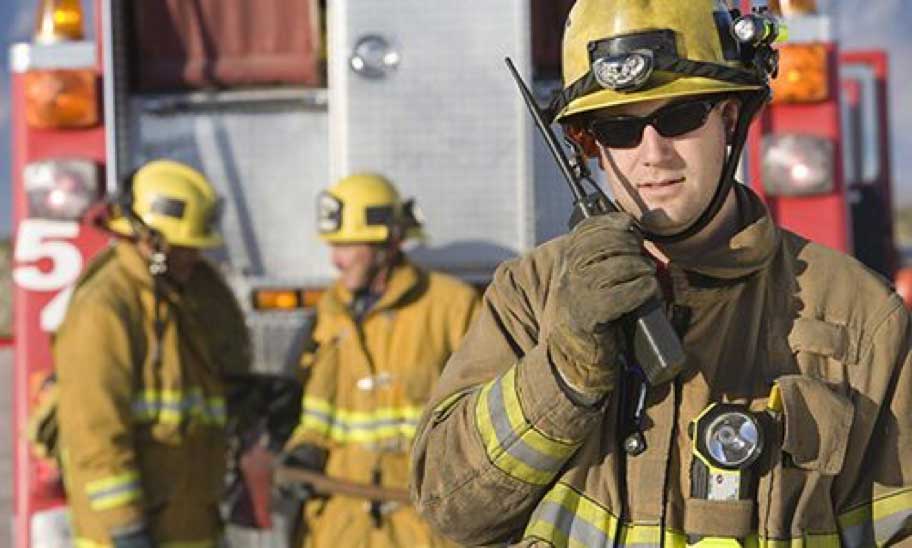
In an emergency, it is vital for first responders to effectively communicate with each other. If a building has poor reception, rescue efforts can be delayed, plus first responders can be put at higher risk.
Therefore, an effective communication system needs to be installed that adheres to first responder codes. In this article, we will review what those codes are to help you determine if your building is compliant.
Read through the guide below and let us know how BearCom can help.
Public Safety Bi-Directional Amplifiers
Before you can establish if your building complies with first responder codes for wireless signal coverage, it is important to know what kind of system is needed.
To keep first responders connected with each other, it is important to have a properly installed in-building communications system. A Bi-Directional Amplifier (BDA) is a signal booster that sustains two-way radio communications throughout a building. This includes areas with poor reception, like parking garages, underground tunnels, stairwells, and elevators.
Public Safety BDAs are used by first responders on their wireless frequencies, which are typically the 450/700/800 MHz bands. Many localities require that signal boosters be installed so that firefighters, police officers, EMTs, and other first responders can effectively communicate with each other throughout any part of a facility.
First Responder Codes

Wireless coverage code laws were developed after 9/11 because first responders could not communicate effectively with each other inside the World Trade Center Towers. As a result, many organizations issued statutes on in-building wireless coverage. Two such organizations are the National Fire Protection Association (NFPA) and the International Fire Code (IFC).
The IFC-510 code requires 95 percent of in-building wireless signal coverage with a signal strength of -95 dB.
NFPA 72, Chapter 24 requires 90 percent of in-building wireless signal coverage, which jumps to 99 percent for critical areas like elevator lobbies and fire pump rooms, as well as exit stairs and passageways.
Furthermore, equipment supporting a public safety network has to function up to 24 hours on backup power or battery, and be housed in a NEMA-4 compliant enclosure. This provides protection against the elements, like rain, sleet, or snow. It also protects against water spray from fire hoses, falling dirt, and windblown dust.
Meeting Safety Standards
Signal booster equipment must also comply with Federal Communications Commission (FCC) regulations. If a signal booster is poorly designed and/or improperly installed, it can interfere with wireless networks. This would result in dropped or blocked emergency calls.
Plus, first responders will not be able to communicate with each other. As a result, this would endanger safety teams and delay rescue efforts.
That is why it is crucial to meet all mandated safety standards. There are various tests to determine if your facility meets these requirements. First, there is a commissioning test performed to determine radio frequency cable performance with optimized system settings. Next, there’s an acceptance test that’s done by the Authority Having Jurisdiction (AHJ). Finally, an annual system performance and backup battery test to ensure that everything is working properly.
Installing a Code-Compliant Communication System
A great way to make sure your building complies with first responder codes is by working with an experienced wireless systems-integration partner such as BearCom. Our team can find the public safety frequencies in your area to design and deploy a system that meets all jurisdictional coverage testing protocols and FCC guidelines.
For a FREE consultation or to request a site-walk, call the BearCompliance Hotline at 844.883.8904.
Or submit an inquiry today.

MOTOROLA, MOTOROLA SOLUTIONS and the Stylized M Logo are trademarks or registered trademarks of Motorola Trademark Holdings, LLC and are used under license. All other trademarks are the property of their respective owners. © 2018 Motorola Solutions, Inc. All rights reserved.
 In an emergency, it is vital for first responders to effectively communicate with each other. If a building has poor reception, rescue efforts can be delayed, plus first responders can be put at higher risk.
Therefore, an effective communication system needs to be installed that adheres to first responder codes. In this article, we will review what those codes are to help you determine if your building is compliant.
Read through the guide below and let us know how BearCom can help.
In an emergency, it is vital for first responders to effectively communicate with each other. If a building has poor reception, rescue efforts can be delayed, plus first responders can be put at higher risk.
Therefore, an effective communication system needs to be installed that adheres to first responder codes. In this article, we will review what those codes are to help you determine if your building is compliant.
Read through the guide below and let us know how BearCom can help.
 Wireless coverage code laws were developed after 9/11 because first responders could not communicate effectively with each other inside the World Trade Center Towers. As a result, many organizations issued statutes on in-building wireless coverage. Two such organizations are the National Fire Protection Association (NFPA) and the International Fire Code (IFC).
The IFC-510 code requires 95 percent of in-building wireless signal coverage with a signal strength of -95 dB.
NFPA 72, Chapter 24 requires 90 percent of in-building wireless signal coverage, which jumps to 99 percent for critical areas like elevator lobbies and fire pump rooms, as well as exit stairs and passageways.
Furthermore, equipment supporting a public safety network has to function up to 24 hours on backup power or battery, and be housed in a NEMA-4 compliant enclosure. This provides protection against the elements, like rain, sleet, or snow. It also protects against water spray from fire hoses, falling dirt, and windblown dust.
Wireless coverage code laws were developed after 9/11 because first responders could not communicate effectively with each other inside the World Trade Center Towers. As a result, many organizations issued statutes on in-building wireless coverage. Two such organizations are the National Fire Protection Association (NFPA) and the International Fire Code (IFC).
The IFC-510 code requires 95 percent of in-building wireless signal coverage with a signal strength of -95 dB.
NFPA 72, Chapter 24 requires 90 percent of in-building wireless signal coverage, which jumps to 99 percent for critical areas like elevator lobbies and fire pump rooms, as well as exit stairs and passageways.
Furthermore, equipment supporting a public safety network has to function up to 24 hours on backup power or battery, and be housed in a NEMA-4 compliant enclosure. This provides protection against the elements, like rain, sleet, or snow. It also protects against water spray from fire hoses, falling dirt, and windblown dust.




